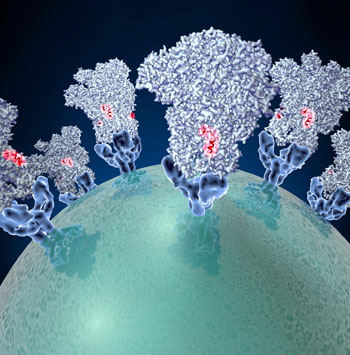Structural Analysis Reveals Potential Coronavirus Vaccine Targets
By LabMedica International staff writers
Posted on 06 Mar 2016
High-resolution analysis of the coronavirus spike glycoprotein (S) has revealed common binding, fusion, and antigenic sites that may be exploited for the development of a broad spectrum vaccine against this family of viruses that includes the human pathogens SARS-CoV (severe acute respiratory syndrome coronavirus) and MERS-CoV (Middle East respiratory syndrome coronavirus).Posted on 06 Mar 2016
Entry of coronaviruses into cells is mediated by the transmembrane spike glycoprotein S, which forms a trimer, which carries receptor-binding and membrane fusion functions. The S glycoprotein also contains the principal antigenic determinants and is the target of neutralizing antibodies.

Image: Entry of coronaviruses into cells is mediated by the transmembrane spike glycoprotein S, which forms a trimer, which carries receptor-binding and membrane fusion functions (Photo courtesy of Veesler Laboratory, University of Washington).
Investigators at the University of Washington (Seattle, USA) used computer enhanced cryo-electron microscopy to conduct detailed structural studies of the S glycoprotein and the coronavirus infectious mechanism. Researchers have historically relied on NMR and X-ray diffraction techniques to determine the structures of molecular complexes and proteins that play a role in the causes of various disease states. Cryo-EM is a complementary analytical technique that provides near-atomic resolution without requirements for crystallization or limits on molecular size and complexity imposed by the other techniques. Cryo-EM allows the observation of specimens that have not been stained or fixed in any way, showing them in their native environment while integrating multiple images to form a three-dimensional model of the sample.
The super high resolution 0.4 nm structure of a mouse coronavirus glycoprotein S trimer ectodomain obtained by single particle cryo-electron microscopy was published in the February 8, 2016, online edition of the journal Nature. The structural analysis revealed the metastable pre-fusion architecture of glycoprotein S and highlighted key interactions stabilizing it. The structure shared a common core with paramyxovirus F proteins, implicating mechanistic similarities and an evolutionary connection between these viral fusion proteins.
"The structure is maintained in its pre-fusion state, and then undergoes major rearrangements to trigger fusion of the viral and host membranes and initiate infection," said senior author Dr. David Veesler, assistant professor of biochemistry at the University of Washington.
"Our studies revealed a weakness in this family of viruses that may be an ideal target for neutralizing coronaviruses," said Dr. Veesler. "Small molecules or protein scaffolds might eventually be designed to bind to this site to hinder insertion of the fusion peptide into the host cell membrane and to prevent it from undergoing changes conducive to fusion with the host cell. We hope that this might be the case, but much more work needs to be done to see if it is possible. Such strategies would be applicable to several existing coronaviruses and to emerging future strains of coronavirus that conserve this same structure for entering cells."
Related Links:
University of Washington













